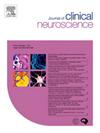Comparative evaluation of intracranial vertebral artery calcification detection: CT vs. susceptibility-weighted imaging
IF 1.9
4区 医学
Q3 CLINICAL NEUROLOGY
引用次数: 0
Abstract
Background and aims
Traditionally, computed tomography (CT) has been more sensitive in detecting calcification compared to conventional magnetic resonance (MR) imaging. This study aims to compare the efficacy of susceptibility-weighted imaging (SWI), an advanced MR technique, with CT in detecting calcification in the intracranial vertebral artery.
Methods
This retrospective study reviewed brain SWI imaging of patients from January 2021 to March 2022. Inclusion criteria encompassed patients who underwent both SWI and brain CT within a 3-month interval. Exclusion criteria included poor imaging quality, insufficient or incomplete studies, and lack of MRA data. Vessel wall calcification was defined as hypointensity on SWI and hyper-attenuation (≥130 HU) on CT. We compared the incidence of calcification detected by CT with hypointensity on SWI at corresponding anatomical locations.
Results
A total of 817 patients (age range: 25–90 years, mean age: 62.1 ± 15.1 years) were included in the study. Of these, 393 (48.1 %) were females, 329 (40.3 %) had hypertension, and 242 (29.6 %) had diabetes. CT detected calcification in 613 intracranial vertebral arteries. SWI depicted hypointensity in 604 (98.5 %) of the CT positive cases. 21 subjects showed calcification on CT but no hypointensity on SWI, while 12 subjects had SWI hypointensity but no evidence of calcification on CT.
Conclusion
This study demonstrates that SWI is not inferior to CT in detecting intracranial vertebral artery wall calcification. SWI is possibly better than CT in detecting non-stenotic atherosclerosis, mural hematoma or dissection. The high concordance between SWI and CT, coupled with SWI’s ability to potentially detect additional vascular pathologies, shows promise as a radiation-free, comprehensive imaging modality.
求助全文
约1分钟内获得全文
求助全文
来源期刊

Journal of Clinical Neuroscience
医学-临床神经学
CiteScore
4.50
自引率
0.00%
发文量
402
审稿时长
40 days
期刊介绍:
This International journal, Journal of Clinical Neuroscience, publishes articles on clinical neurosurgery and neurology and the related neurosciences such as neuro-pathology, neuro-radiology, neuro-ophthalmology and neuro-physiology.
The journal has a broad International perspective, and emphasises the advances occurring in Asia, the Pacific Rim region, Europe and North America. The Journal acts as a focus for publication of major clinical and laboratory research, as well as publishing solicited manuscripts on specific subjects from experts, case reports and other information of interest to clinicians working in the clinical neurosciences.
 求助内容:
求助内容: 应助结果提醒方式:
应助结果提醒方式:


